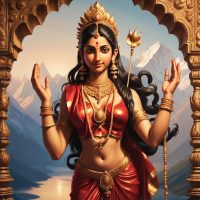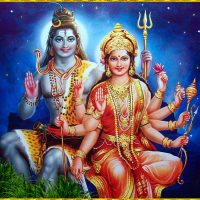Parvati : The Benevolent One
Listen
At a glance
| Description | |
|---|---|
| Origin | Indian Mythology |
| Classification | Gods |
| Family Members | Himavan (Father), Meva (Mother), Shiva (Husband), Ganesha (Son), Karthikeya (Son) |
| Region | India, Nepal, Bhutan |
| Associated With | Love, Compassion, Nurturing |
Parvati
Introduction
Parvati, a central figure in Hinduism, embodies grace, strength, and devotion as the wife of the powerful Shiva, the destroyer god, representing the creative and nurturing aspect of the divine feminine. From her initial yearning for love to her transformation into a fierce protector, her journey is a captivating exploration of love, duty, and inner strength. Parvati stands as a figure of profound significance and reverence, symbolizing fertility, love, and devotion, captivating both divine and mortal realms with her unwavering grace. Known also as Uma, she is associated with power, love, beauty, and maternity, serving as the wife of Shiva and mother to gods Ganesha and Kartikeya. Parvati’s divine feminine energy is celebrated for its nurturing and protective qualities, extending her significance beyond mythology into temples dedicated to her worship and her pervasive presence in various forms of art and culture.
Physical Traits
Parvati’s physical presence exudes radiance and youthfulness, characterized by fair skin adorned with intricate golden jewelry and exquisite silk drapery. Her four arms symbolize the depths of her multifaceted nature, each holding significant objects such as a lotus representing purity, a mirror symbolizing self-knowledge, a trident signifying power, and a noose representing attachment or detachment. Behind her calm demeanor lies a wellspring of inner strength, while her gentle smile emanates boundless compassion. Her physical beauty serves as a tangible manifestation of the divine qualities and inner virtues she embodies.
Elevated to the status of a goddess, Parvati’s divine essence is further accentuated by the resplendent jewelry and garments she wears, enhancing her celestial presence. Depictions often showcase her holding objects like a lotus, vase, rosary, mirror, or trident, each symbolizing different aspects of her divine nature. Enchanting all who behold her, Parvati’s radiant beauty and graceful charm are revered by her devotees, serving as a timeless symbol of femininity, fertility, and the eternal cycles of nature.
Family
Parvati’s familial ties are intricately woven into her mythology, serving as a cornerstone of her divine identity. Born as the daughter of Himavan, the king of the mountains, and Mena, a revered queen, her lineage is steeped in celestial significance. Alongside her sister, the sacred river Ganga, Parvati embodies the essence of the divine feminine, her presence spanning across various realms of Hindu mythology.
Her sacred union with Shiva, the supreme god, symbolizes the harmonious balance between masculine and feminine energies, reflecting the complementary roles they embody within the cosmos. As a mother, Parvati’s unconditional love and protective instincts extend to her sons, Ganesha and Kartikeya, who hold prominent positions as revered deities within Hinduism.
Parvati’s association with powerful goddesses like Durga and Kali further emphasizes the multifaceted nature of the divine feminine, encompassing both nurturing and fierce aspects. Despite her illustrious lineage and divine connections, it is her unwavering love and devotion to Shiva that defines her familial identity, transcending mortal comprehension and symbolizing the eternal bond between masculine and feminine energies in the universe.
Other names
Parvati’s divine presence is invoked through a myriad of names in Hindu literature, each encapsulating distinct facets of her divine nature. From Uma and Gauri, signifying purity and radiance, to Durga and Kali, representing her fierce and protective aspects, her multifaceted identity resonates across the cosmos. Associated with mountains, names like Shailaja and Haimavati denote her connection to the majestic Himalayas, while Aparna reflects her ascetic practices and Hemavati her unparalleled beauty.
As the gentle Gauri or Girija, she embodies nurturing love, while as Durga or Kali, she epitomizes fierce determination, wielding the power to vanquish evil and restore cosmic balance. Parvati’s diverse names mirror the complexities of the divine feminine, underscoring her role as both a compassionate mother and a formidable warrior. Whether invoked as Uma, Jagdamba, or Maheshvari, each name serves as a testament to her boundless grace and unwavering devotion, transcending mortal understanding and illuminating the eternal essence of the goddess.
Powers and Abilities
Parvati’s divine prowess is a reflection of her boundless love for Lord Shiva, encompassing both nurturing and destructive aspects of creation. As the goddess of fertility, she orchestrates the cycles of birth and renewal, bestowing abundance and prosperity upon her devotees. Renowned for her martial prowess, she adeptly wields weapons, safeguarding the cosmos from demonic threats. However, it is her inner strength and unwavering devotion that truly distinguish her, guiding mortals towards righteousness and spiritual enlightenment.
Parvati’s powers are formidable, ranging from her role as Shiva’s creative energy, driving creation and transformation, to her mastery of illusion and shapeshifting, enabling her to adapt to any situation. Her blessings bring prosperity, while her curses are equally potent. Yet, it is her unwavering devotion to Shiva that serves as her most potent power, inspiring devotees worldwide.
As the embodiment of feminine divinity, Parvati represents the eternal cycles of life, death, and rebirth, wielding both creative and destructive forces. Revered as a primordial mother goddess, she manifests fearsome forms to combat evil, embodying the divine essence of creation and nurturing energy.
Modern Day Influence
As a symbol of marital harmony, her relationship with Shiva exemplifies the perfect blend of masculine and feminine energies, inspiring couples towards harmonious relationships. Her unwavering devotion to Shiva serves as a beacon of perseverance, teaching the importance of dedication and focus in pursuing one’s desires.
Parvati embodies the essence of Shakti, symbolizing the innate strength and potential within every woman. Her portrayal in art and literature continues to captivate audiences, serving as a muse for artists and writers alike. From sculptures to classical Indian literature, her stories and imagery endure, enriching cultural heritage.
In contemporary festivals like Navratri, Gauri Festival, and Gangaur Festival, Parvati is worshipped, symbolizing prosperity, harmony, and devotion. Devotees worldwide honor her through elaborate rituals and devotional practices, seeking her blessings for abundance and protection.
Parvati’s message of love, devotion, and resilience resonates deeply with modern audiences, offering solace and guidance amidst life’s challenges. Her timeless beauty and divine grace continue to inspire, reminding humanity of the power within gentleness and the strength found in unwavering devotion.
Related Images
Frequently Asked Questions
What is lorem Ipsum?
I am text block. Click edit button to change this text. Lorem ipsum dolor sit amet, consectetur adipiscing elit. Ut elit tellus, luctus nec ullamcorper mattis, pulvinar dapibus leo.
What is lorem Ipsum?
I am text block. Click edit button to change this text. Lorem ipsum dolor sit amet, consectetur adipiscing elit. Ut elit tellus, luctus nec ullamcorper mattis, pulvinar dapibus leo.
What is lorem Ipsum?
I am text block. Click edit button to change this text. Lorem ipsum dolor sit amet, consectetur adipiscing elit. Ut elit tellus, luctus nec ullamcorper mattis, pulvinar dapibus leo.
What is lorem Ipsum?
I am text block. Click edit button to change this text. Lorem ipsum dolor sit amet, consectetur adipiscing elit. Ut elit tellus, luctus nec ullamcorper mattis, pulvinar dapibus leo.
What is lorem Ipsum?
I am text block. Click edit button to change this text. Lorem ipsum dolor sit amet, consectetur adipiscing elit. Ut elit tellus, luctus nec ullamcorper mattis, pulvinar dapibus leo.













